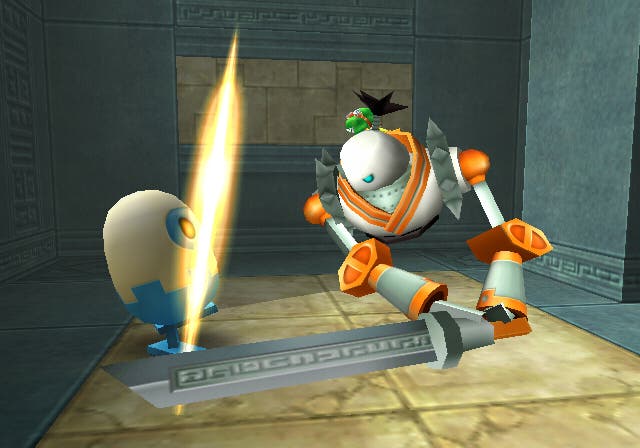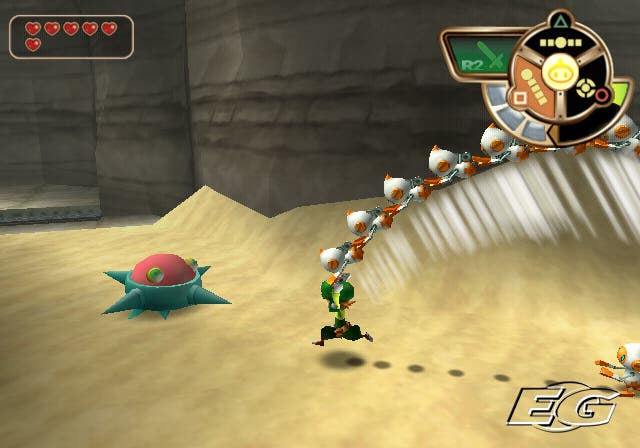Tokobot Plus: Mysteries of the Karakuri
Super Robot Friends.
You'll have to forgive the lack of a clever introduction to this review. The original plans involved some witty observations about the disappointing lack of robot servants in my home (possibly including a domestic insight into the state of my laundry basket), a dig at the utter uselessness of Honda's stair-climbing Asimo, and a brief sighing look back at the golden age of robots we were promised by science fiction authors decades ago. The whole affair would have been capped off with a clever tongue in cheek mention of the fact that we're also still waiting for flying cars. It would have been, in other words, a satisfying if not entirely unpredictable opening paragraph which would have put you into a fine mood to read a quick review of a game with friendly robots in it.
Unfortunately, these plans were ruined - nay, cast down - by the discovery that mere months ago, Ellie had already slagged off Asimo and the lack of useful robot servants in the introduction to her review of Tokobot on the PSP. Granted, we could probably have tweaked the paragraph, added in the brief flying car reference, and run it again; it's unlikely anyone would notice. But then again, sometimes honesty is the best policy. We're all out of clever robot paragraphs. As it happens, Tecmo is all out of clever robot games, too, but they've decided that tweaking the last one, adding in a few bits and just running it again isn't such a bad idea after all.
Mad About The Bot

Tokobot Plus: Mysteries of the Karakuri is essentially a port of the PSP version of the game, and the addition of five whole words to the title (a whopping 500 per cent increase in titular content!) belies the fact that there hasn't really been very much added to the game itself since it graced handhelds last year. There's a little expanded content - new secrets to be found on existing levels, a couple of new bonus levels, and a little more depth to the storyline sequences - and the controls are somewhat tweaked, but otherwise this is pretty much exactly the same game. Graphically there isn't much to choose between them, although the PS2 iteration looks like it's got marginally better animation; however, expanding the game up onto a TV screen unpleasantly emphasises the claustrophobic and restrictive design of many of the areas of the game. Worse, the developers have tried to fix the camera - which was criticised in the PSP version - and have actually broken it even more, to the extent that it now regularly gets stuck behind objects or attached to walls. Oops.
For those who are unfamiliar with the game - it's probably safe to say that's a majority of people - Tokobot is a platform puzzler which puts you in control of a number of helpful robots, and tasks you with exploring a variety of ancient ruins and tombs to find out the secrets of their creators. The storyline is distinctly from the young children's TV school of anime, meaning that it's brightly coloured and quite good fun but not exactly deep or involving; the addition of new dialogue in the PS2 version of the game doesn't really add much to the mix, although it does make the whole thing a bit more coherent.

The tokobots can be used both for combat and for puzzle solving, and they are controlled by putting them into a variety of formations which changes their function; the normal formation is for them to follow you in a straight line, allowing you to whip them out ahead of you to attack, while a horizontal line formation (with bots on either side of you) permits a spinning attack, and a circular formation allows a stomp attack. One positive side of the PS2 port is that the three formations are mapped directly to buttons on the face of the pad, which is a much more natural way to control the game than the rotation system used on the PSP.
The other thing tokobots can do is transform into an entirely different giant robot form, a special move called an Overdrive. There are various different forms, which are used for a variety of puzzle solving and combat purposes. However, Tecmo has chosen to change how these forms are accessed in the PS2 version of the game. While on the PSP, you transformed into a giant robot where required and piloted it until a timer ran out, the home console version of Tokobot turns the giant robots into something akin to Final Fantasy's limit breaks - a bar fills up as you take damage, and you can "summon" a robot form once the bar is full. It's a nice idea, but sadly it's one which has been introduced with little regard to the balance of the game; the bar fills up ridiculously quickly, meaning that the Overdrive abilities rapidly become the mainstay of your combat strategy, which makes the battle parts of the game pathetically easy.
Touch My Bot
This flaw is less serious than it sounds, because combat really isn't the heart of Tokobot's gameplay in the first place - platforming and action both play second fiddle to puzzle solving. Unfortunately, in this regard the flaws of the PSP game have gone completely uncorrected in the PS2 edition - and while the puzzles remain relatively interesting, they're far from compelling enough to warrant a strong recommendation. The problem is that they're altogether too simple; not in the sense of a good kids' game (and we do bear in mind that Tokobot is at least partially aimed at youngsters), where there are logic puzzles that pose a marginal challenge but still give you a chance to experiment and work things out for yourself, but in the sense of a poor kids' game where the designers have created puzzles, had a panic attack over whether they're too hard and put in massive signposts pointing at the solutions to compensate.

So you'll never actually be stuck in Tokobot; the puzzles are all robbed entirely of their essence by the placement of enormous cues around them which aren't so much clues as solutions. In the absence of logical difficulty, though, the developers have instead made it so that solving some of the problems presented is a pain in the arse due to fiddly controls or poorly designed interfaces. This is weak design; any game where you can see exactly what you need to do, but can't do it because the controls are over-sensitive or because pixel perfection is demanded, should go back to the drawing board for a rethink. This flaw with Tokobot on the PSP was highlighted, and didn't get fixed in the port to PS2; it's not crippling, nor does it actually halt progress through the game too often (indeed, Tokobot is an incredibly short game, something which is barely alleviated in the slightest by the addition of the new bonus content), but it does detract significantly from the enjoyment of what should be a fun, light-hearted and well-presented platform puzzler.
When Eurogamer reviewed this game on the PSP, it was worthy of a six - a mark which seems eminently fair in retrospect. On the PS2, however, the flaws of the game are all the more glaring because the developers had an opportunity to rectify them and chose not to. The bonus content is nice to have, of course, but barely adds anything to the original game, while the conversion of PSP assets and levels to the PS2 is not an entirely comfortable one in this case, and the new camera is even worse than the previous one.
Tokobot Plus remains a cheerful, happy little game - it's got some lovely ideas in places and doesn't take itself too seriously - but it was far more at home on the PSP than it is on a home console, and it has gained pretty much nothing in the transition to the PS2. We'd love to see the team at Tecmo flesh out the concepts introduced with a PSP sequel, or even an original title developed from scratch for the PS2 - but for now, this game is tough to recommend as anything other than a short and somewhat flawed curiosity.

